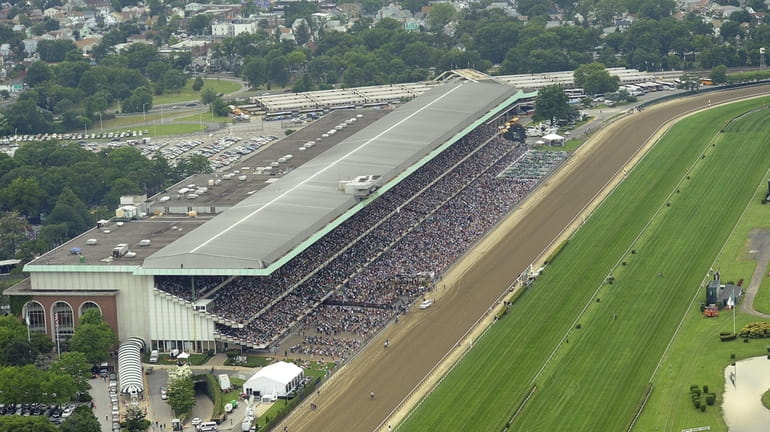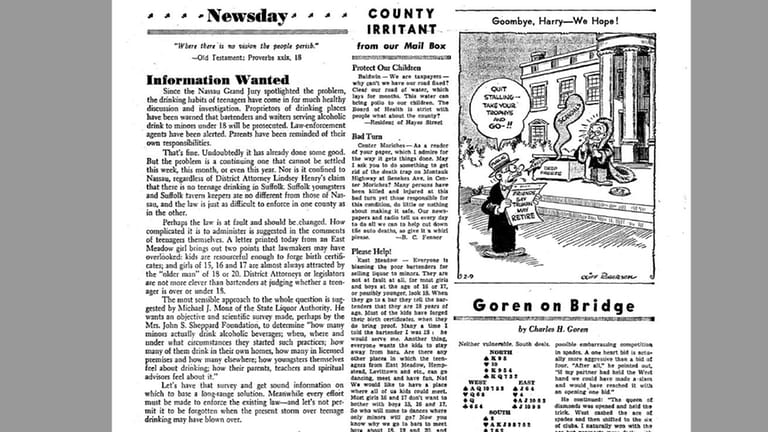An 'ice' reason for a Belmont Park makeover

The grandstand at Belmont Park in Elmont. Credit: Kevin P Coughlin
Daily Point
Ice racing at Belmont?
In Assemb. Ed Ra’s vision, a modern Belmont Park would be more than a home to year-round horse racing.
“The greatest thing would be, if this gets done, to get an Islanders-Rangers Winter Classic there on the property, sell out the grandstand, have a great celebration and watch the Islanders beat the Rangers,” Ra said during a state legislative hearing Thursday.
“I couldn’t agree more,” said New York Racing Association chief executive David O’Rourke.
O’Rourke testified in the middle of the day Thursday, after lawmakers had already sat through hours of testimony from economic development officials and advocates. Perhaps that explains why there weren’t many questions — or much pushback — to NYRA’s primary purpose in being at the hearing: advocating for $455 million in state-backed bonds to allow for the remake of the Belmont Park grandstand and clubhouse.
“Belmont has long been a crown jewel in American horse racing,” O’Rourke said. “But it hasn’t been renovated since 1968.”
O’Rourke also focused on the effect a Belmont renovation would have on Aqueduct Racetrack. The modernization would winterize Belmont, which would then allow the state to move all of Aqueduct’s racing to Belmont.
That, O’Rourke said, would free up 100 acres of developable land for the state to use — land O’Rourke said was worth $1 billion.
Most of the questions were softballs from lawmakers who seemed already supportive. In response to a question from State Sen. Dean Murray, O’Rourke noted the difference between the money the state earmarked for a new Buffalo Bills stadium last year and NYRA’s request. The Bills, he said, were given state grants.
“This is a loan. We will be paying it back,” O’Rourke assured.
With interest? Murray asked.
“Correct.”
O’Rourke noted that Belmont would have ample green space, leaving it potentially available for additional public events or, he said, even weddings. That, he said, could mean that the estimate that the work would add 740 new permanent, full-time jobs could be “conservative.”
“I think we’re going to be a lot higher than that,” O’Rourke said.
Especially if hockey’s Winter Classic comes to Belmont.
— Randi F. Marshall @RandiMarshall
Talking Point
Getting ready for fall
The Suffolk GOP will hold screenings on Saturday for races within the Town of Brookhaven as well as county legislative races within the town, county Republican leader Jesse Garcia tells The Point.
It stands to be a noteworthy gathering given the game of musical chairs that would begin if Brookhaven Town Supervisor Ed Romaine becomes the party standard-bearer in the race for county executive, allowing other town officeholders to try to move up.
Romaine appears to be the front-runner coming out of earlier screenings with Suffolk GOP and Conservative leaders for the top county gig, currently held by Democrat Steve Bellone who is term-limited this year.
There are still plenty of open questions about down-ballot races, however. One of them concerns the 6th Legislative District, where Mount Sinai Democrat Sarah Anker is term-limited and there has been some talk of a run by Suffolk Police Benevolent Association president Noel DiGerolamo, a registered Conservative who is also of Mount Sinai.
DiGerolamo threw cold water on that idea, telling The Point that he is not screening or running for public office, as “there is still much I wish to do in my current position.”
He said he appreciates that “certain individuals would like me” to run: “Over the course of years it's been discussed with certain party leaders, other legislators, my board. However, it's not something that I believe is in the best interest of my membership."
For the upcoming races more broadly, Garcia declined to discuss candidates who had or hadn’t screened for various offices, noting that ones not selected for one seat could be potential candidates for the future.
— Mark Chiusano @mjchiusano
Pencil Point
State of the House

Credit: The Atlanta Journal-Constitution/Mike Luckovich
For more cartoons, visit www.newsday.com/nationalcartoons
Reference Point
The age-old drinking problem

The Newsday editorial from Feb. 9, 1952.
Grand juries are empaneled for all sorts of reasons, but in the early 1950s the Nassau County district attorney convened one to examine the issue of underage drinking. And Newsday’s editorial board applauded its conclusions.
“Since the Nassau Grand Jury spotlighted the problem, the drinking habits of teenagers have come in for much healthy discussion and investigation,” the board wrote in a Feb. 9, 1952 editorial called “Information Wanted.”
“Proprietors of drinking places have been warned that bartenders and waiters serving alcoholic drink to minors under 18 will be prosecuted,” the board continued. “Law-enforcement agents have been alerted. Parents have been reminded of their own responsibilities.”
The board also noted that the problem was not confined to Nassau, “regardless of District Attorney Lindsey Henry’s claim that there is no teenage drinking in Suffolk. Suffolk youngsters and Suffolk tavern keepers are no different from those in Nassau,” the board archly observed.
Administering the law is “complicated,” the board conceded, citing the age-old difficulty of deciding who looks 18 or older. Kids can forge birth certificates, the board said, adding a comment that “girls of 15, 16 and 17 are almost always attracted by the ‘older man’ of 18 or 20. Perhaps, the board opined, the law on the legal drinking age should be changed.
But the most sensible approach, the board concluded, was one suggested by Michael J. Monz of the State Liquor Authority: a survey on underage drinking including statistics and input from teens, parents, teachers and “spiritual advisors.”
Whatever the results of the survey and however long it took for that controversy to subside, if it ever truly did, it took until 1982 for New York’s drinking age to be raised to 19. And it was not until 1985 that New York lawmakers, after several years of heated debate, voted to increase the age to the current 21.
The approval was motivated at least in part by a threat from the federal government: The previous year, President Ronald Reagan had signed into law legislation that any state without the 21-year-old minimum would lose federal highway aid — in New York’s case, more than $90 million in 1987-88.
All of which means Newsday’s editorial board had it right in 1952, when it observed that “the problem is a continuing one that cannot be settled this week, this month, or even this year.”
— Michael Dobie @mwdobie, Amanda Fiscina-Wells @adfiscina
